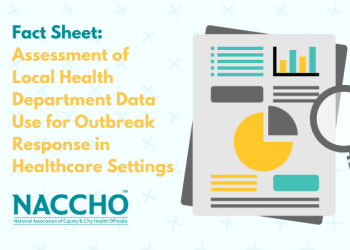Washington, DC, February 20, 2024 – The National Association of County and City Health Officials (NACCHO), the voice of the country’s over 3,300 local health departments, released its 2022 National Profile of Local Health Departments Study (Profile Study) that describes local health department infrastructure, experiences, and services at the national level. The Profile Study data show both point-in-time information, as well as longitudinal change since the 2008 Profile Study. The results help explain the challenges faced by local health departments since the pandemic and underscore the need for increased capacity for health departments of all sizes to provide needed services, particularly to support mental health and infectious disease activities.
The Profile Study is the largest and most reliable data source on local health departments in the United States and presents a complete and accurate overview of how local health department funding, staffing, activities, and partnerships have changed over time. Some key findings include:
Local Public Health Workforce Harassment – Seven in 10 local health departments had leaders and/or staff targeted with harassment because of COVID-19 response activities since the beginning of the pandemic. The most common forms of harassment reported include negative messages about public health protection orders via social media (69%), messages directed at a specific individual (52%), and coordinated online demonstrations against public health protections (27%). Nearly two-thirds (63%) of local health departments that were targeted did not receive any protections from local, state, or federal entities in response to the harassment or threats. A NACCHO analysis from another study found that 3 in 10 local public health staff were considering leaving their positions in 2021 — and those who experienced harassment were more likely to report this.
Staffing and Financial Capacity – In 2022, there were approximately 182,000 employees at local health departments nationwide, compared to 153,000 in 2019 — a growth of approximately 19%, after continuously decreasing between 2008 and 2019. However, this growth is likely temporary as the number of contractual employees at local health departments increased by approximately 175% — more than other types of employees (e.g., full-time, part-time, seasonal) — between 2019 and 2022. Moreover, the increases were not uniform. When broken down by jurisdiction size, large local health departments (i.e., those serving populations of 500,000+) experienced the largest increase in contractual employees. At the time the data were collected, an influx of temporary federal funding was available to support the public health response to COVID-19, which will end in the next few months and create a funding cliff. Relatedly, average per capita revenues from federal sources nearly doubled between 2019 and 2022, from $17 to $31, which indicates the increases in capacity were at least in part due to increases in federal aid. Furthermore, nearly 1 in 5 local health departments foresaw budget cuts in their next fiscal year, as that supplemental COVID-19 federal funding expires and no further federal resources are expected. Sustained investment in local health departments is needed to ensure proper staffing for public health activities outside the emergency setting.
Immunization Access - In 2022, local health departments continued to be key vaccine access points for their communities, with nearly 90% providing routine adult and pediatric vaccination. Moreover, 93% of local health departments implemented strategies to increase routine vaccination uptake among un/under-vaccinated populations. Large local health departments were more likely to use these strategies in comparison to smaller agencies. Approximately 70% of local health departments provided clinics in community settings or expanded walk-in hours/hours of operation to improve access to routine vaccinations. However, most local health departments (69%) conducted this work with fewer than five full-time equivalent staff. With increased sustained funding and staff, local health departments can better scale up to fill gaps in immunization access.
Mental Health Services - The proportion of local health departments engaged in assuring access to behavioral health care services increased from 40% in 2010 to 61% in 2022. In addition, more local health departments partnered with mental health/substance abuse providers (32%) than directly provided population-based primary prevention services addressing mental health (20%) or mental/behavioral health clinical services (12%). This highlights the importance of cross-sector partnerships to address gaps in mental health services.
Informatics and Data - Local health departments continue to increase their use of multiple data systems, including immunization registries, electronic disease reporting systems, electronic lab reporting, electronic health records, as well as the use of health information exchanges. Notably, implementation of electronic health records increased by 42 percentage points between 2008 and 2022; while participation in health information exchanges increased 24 percentage points over the same period. The data helps underscore areas where increased investment and attention can be focused for future data modernization efforts.
# # #
About the 2022 Profile Study
For the 2022 Profile Study, a total of 2,512 local health departments were included in the study population. Rhode Island was excluded from the study because the state health agency operates on behalf of local public health and has no sub-state units. All local health departments in the study population received the Core questionnaire. A random sample of local health departments also received one of the two sets of supplemental questions. NACCHO administered the survey from June through September 2022. Overall, the 2022 Profile Study had 942 local health departments respond, for a response rate of 38%. Deidentified data from the 2022 Profile Study will be made publicly available through ICSPR’s data repository in summer 2024. For access to prior years’ Profile data and data use policies for Profile data, please visit: https://www.icpsr.umich.edu/web/pages/ICPSR/index.html. For more information about NACCHO’s Profile Study, please visit www.naccho.org/profile.
About NACCHO
The National Association of County and City Health Officials (NACCHO) represents the nation’s over 3,300 local governmental health departments. These city, county, metropolitan, district, and tribal departments work every day to protect and promote health and well-being for all people in their communities. For more information about NACCHO, please visit www.naccho.org.





